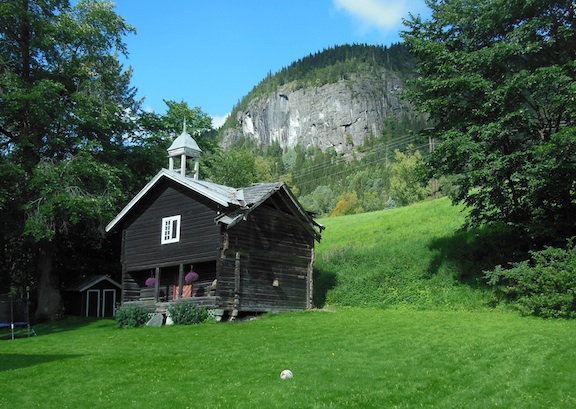
Kraabol storage building, perhaps built about 1600.
photo Elroy Christenson 2016
Gulbrand Bottolvsson of
Kråbøl
b. abt 1400 Kråbøl/Krååkbol (perhaps Lillehammer) , Vestre
Gausdal, Oppland, Norway
d. Vestre Gausdal, Oppland, Norway
m. Amundsdatter
Norway
b. Norway
d. Norway
her father: unknown
her mother:unknown
his father: Bottolv Bjørnsen of Kråbøl
(b.1310 Vestre Gausdal, Oppland, Norway)
his mother: Ronnaug Eysteinsdatter of Kråbøl
| Child |
|||
|---|---|---|---|
| Bjørn
Gulbrandsen |
b. 1430 Krabøl, Vestre Gausdal, Oppland, Norway |
d. |
m. unknown
|

The records beyond this point are very sketchy and difficult to
come by. Some of this history was laid out by a ships
captain named Hans Kråbøl, in 1820-1824. The work was
finally published in 1922. I'm pretty certain that the Kråbol farm
was a property of the local nobility. Consequently many of
the folks who lived on the land were serfs or perhaps even
slaves. This up-land or Oppland area is rebounding area from
the glaciers which was eventually becomes heavily forested and
presently is one of the centers of forestry and goat cheese
production in all of Norway.
Even though we have very little information on the family there
were events in the early history of the area that caused the
locals a great deal of difficulty.
Norway National
Archives.
records of LDS,
International Genealogical Records, 1999-
familysearch.org
Kim, Shin. Early Years of the Little Ice Age in
Northern Europe. Korean Minjok Leadership Academy,
International Program. 2007. http://www.zum.de/whkmla
World History of
Norway,
http://www.zum.de/whkmla/region/scandinavia/xnorway.html
Oppland records
on GENI.com managed by Ingar Benjamin Nordby 2015
Brief History of Oppland || Elroy's Family Index || Select Norway Farm Index || Ancestor Chart #24090






All information and
photos included within these pages was developed by
the help of hundreds of researchers. The information
here is for the express purpose of personal
genealogical research and is freely offered as long as
this site is listed as a source. It may not be
included or used for any commercial purpose or
included in any commercial site without the express
permission of Elroy Christenson. Copyright Elroy
Christenson 1998-2016.